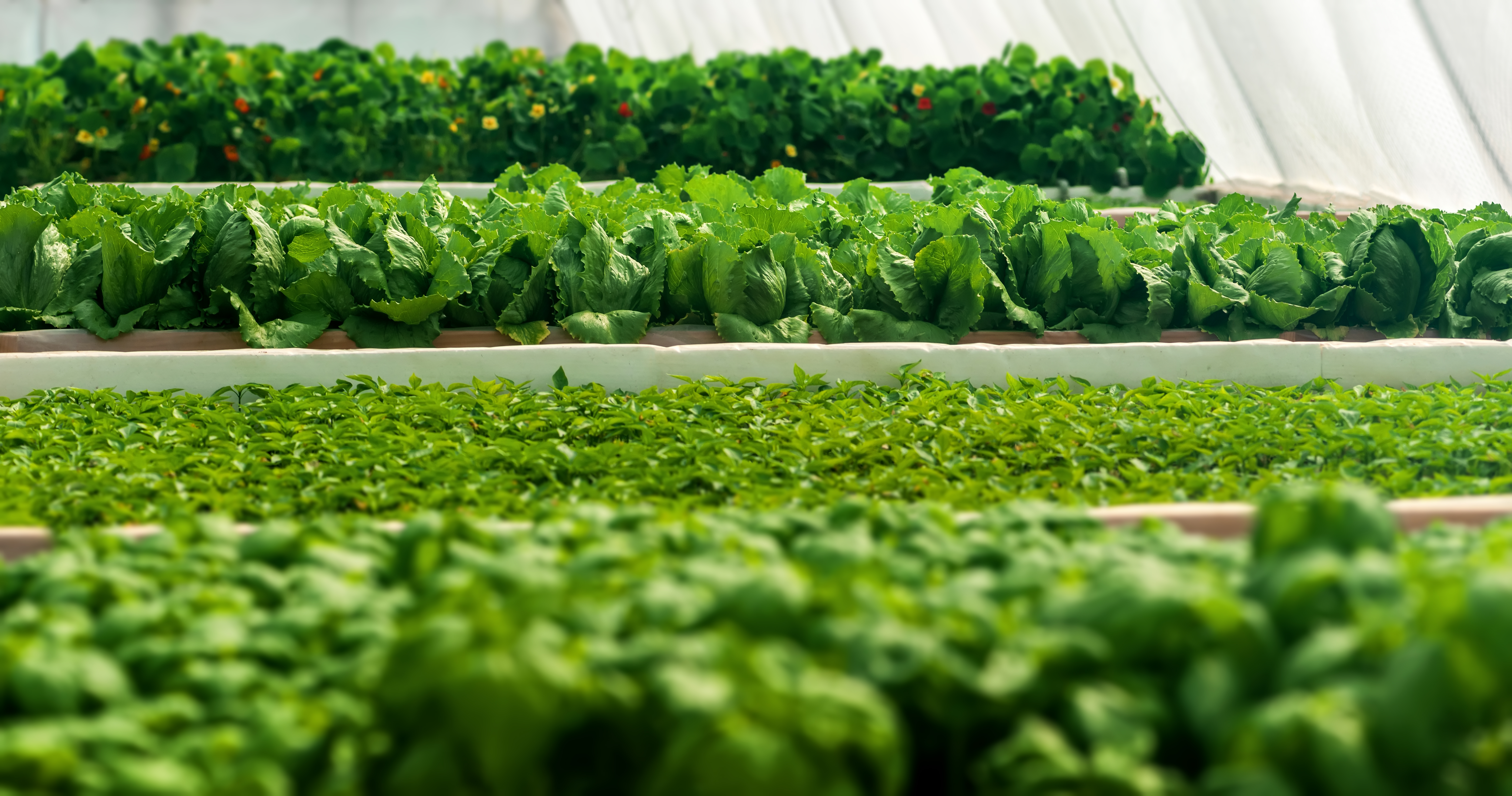Hydroponic farming is the process of growing plants and vegetables via a carefully calibrated mineral-rich water solution, whereby the plants continuously imbibe and process the nutrients made available to them. In this approach, growers can precisely control the nutrients needed by the plant at different stages of its growth. It also provides the ability to positively influence the availability of other vital inputs to the roots such as oxygen and beneficial microbes—micro-attention to plant health results in growth that is 30 – 50% faster. Additionally, there will be fewer cases of plant decay and wilting and the ability to avoid chemical means of parasite control.
 As hydroponic farms are designed with high-precision control, they are predominantly housed in protected (climate controlled) environments allowing for year-round growing. This allows hydroponic farms to increase productivity by up to 100 times as compared to traditional farming.
As hydroponic farms are designed with high-precision control, they are predominantly housed in protected (climate controlled) environments allowing for year-round growing. This allows hydroponic farms to increase productivity by up to 100 times as compared to traditional farming.
There are however many variations of hydroponic growing – aquaponics, aeroponics, dryponics (to name a few) and different techniques within each of these. There is no simple answer to which of these is superior; that depends on the crop, location (climate) and other factors.
Plants make their vitamins, so vitamin levels tend to be similar whether a vegetable is grown hydroponically or in soil. It is the ability to enhance the mineral content (like iron, calcium, magnesium, potassium) that sets hydroponic methods apart. Phyto-nutrients, on the other hand, are produced by the plants in reaction to the environment and stimulus that they are provided with. For example, tomatoes can be redder because of more lycopene, the magical antioxidant. Kale & spinach can have more chlorophyll and iron. The result is that vegetables grown hydroponically are often nutritionally superior to traditionally grown ones. The key to achieving this, however, is in the considered calibration and high-precision control in providing these inputs to the plants. And not all hydroponic growers get this right!
One must also consider how fresh the produce is may have more of an impact on its nutrient quality than how it was grown. Lettuce or tomatoes from a local hydroponic grower will be more nutritious than conventional or organic produce that has spent a week in transit, simply because less time has elapsed.
Finally, for some vegetables, the specific variety may have more of an impact on the flavour than whether it was grown in soil or a hydroponic medium. Good hydroponic farms spend much time and trials on getting this right.
Most of the parasites that inhibit plant health originate from soil (pests, fungi, weeds). With no soil, hydroponic growing reduces the incidence of harmful matter, allowing the plants to naturally combat these without assistance from toxic chemicals (pesticides, fungicides, and weedicides). Reduced parasites also will enable the plant maximum access to the nutrition meant for its consumption, thus forming a virtuous cycle of creating healthier, more resilient plant.
As hydroponic farms are designed with high-precision control, they are also predominantly housed in protected (climate controlled) environments providing for a pollutant and pathogen-free growing habitat. This results in inherently cleaner and more robust produce.
With up to 95% savings in water consumed, up to 90% savings in land footprint, and up to 70% savings in labour required, hydroponics is immensely resource friendly and makes it a viable option in urban areas, closer to consumers. This dramatically minimizes carbon-intensive ‘food miles’ that traditional farming incurs. A cleaner planet, greener cities and healthier people are the most significant factors driving hydroponics
Hydroponic companies, just like traditional farms, have the option to make organic and non-organic choices. While most use nutrients (like nitrogen, phosphorus, potassium) in ionic forms derived from chemical salts, there are emerging organic options available. Selection of growing media to support the plants is also an important consideration – there are many synthetic (foam, plugs) and natural (pear, coco-choir, rockwool) media that both work well.
But in general, they do not use synthetic fertilizers like urea, diammonium phosphate and several toxic pesticides and herbicides of conventional crops.
In other words, not all traditional farms are organic; not all hydroponic farms are organic. But they can be, based on the choices made by the grower.
Every living organism has an inherent natural potential as coded in its genetics. The goal of hydroponics (together with controlled environment farming) is to allow the plants to achieve this genetic potential to its fullest by providing them with the ideal conditions and inputs and by eliminating deterrents (parasites and environmental extremities). A well-cared-for, and the healthy plant is naturally more resilient and nourishing than one that must expend most of its energy to survive. Furthermore, the most critical natural process for plant growth, photosynthesis, remains the same.
The absence of soil in hydroponics is often seen as being unnatural. Soil is essentially an expensive foundation or growing media that supports a vast ecosystem that plants use. Soil can be easily replicated through other growing media without sacrificing the microbial environment the plant needs. Nutrients are presented to the plant-based on scientific study and delivered through high-precision control. However, the plant still decides to use what it needs to thrive and grow.
Hydroponic produce is often slightly dearer than traditional alternatives owing to the degree of technology and craft that goes into growing higher quality, nutritionally denser, and more flavourful food. However, they are significantly cheaper than most organic produce. With hydroponic farms that are closer to you, you would be paying lesser for transport and handling and the premium directly translates into a superior and cleaner product. With increase in scale and prevalence of hydroponic farms, the costs of enabling technology are also rapidly coming down.
Hydroponics is a form of precision agriculture that requires significantly higher capital and technical knowledge to set up and operate. While increased yields and improved quality compensate some of these higher costs, it still poses a high entry barrier to make it more prevalent.
Hydroponic farms are relatively more energy-hungry. Energy costs often limit the amount of control one can viably include in the setup. As more energy-efficient equipment and technology get introduced, greater ability to create optimal environments for plant growth will emerge.
Finally, commercial applications of hydroponics are limited to a few fruits and vegetables. While some success has been made in growing staple crops like rice and pulses, these almost entirely remain under the realm of traditional field cropping. Till more crops are grown commercially, hydroponics will co-exist with conventional farming in our quest to feeding the world.
Author : Karthik Rajan
Founder of LivFresh Farms, Singapore


Leave A Comment